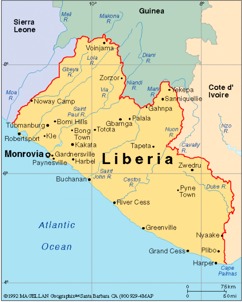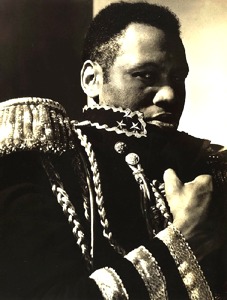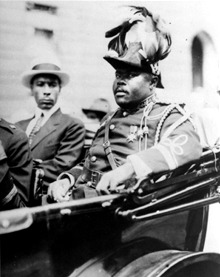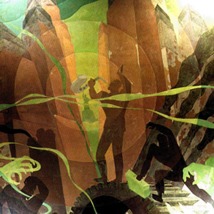


The Image of Africa in the Literature
of the Harlem Renaissance
Overview
| [+] | |
 Africa |
|
Unwitting heirs to prevailing white American mythology, many descendants of Africans who were enslaved in America believed that they had few complimentary ties to Africa. It was a dark land from which, as poet Phillis Wheatley asserted in the late eighteenth century, they had been mercifully rescued. Another strand of thought, however, the one that led colonization societies to consider parts of Africa as a place to which enslaved Africans should return and that led black missionaries on trips to the Continent,
| [+] | |
 Liberia |
|
With leaders such as W. E. B. Du Bois emerging to counter the accommodationist stances of Booker T. Washington, who was the most revered African American leader in the late nineteenth and early twentieth centuries, blacks began to look for sources of pride that did not locate their origins in America slavery. They got rid of what poet Eugene Redmond has described as a “shore to shore” mentality, that is, identifying with African American history only from the Atlantic to the Pacific oceans, that is, within the borders of the continental United States. A turning to Africa on the parts of some African Americans was an understandable direction in which to seek. The formation of the National Association for the Advancement of Colored People (NAACP), with Du Bois at the helm, posited a slightly more aggressive quest for equal rights for persons of African descent and a pride within African American communities that had not had previous outlets for full expression. These social and political factors, combined with the migrations of hundreds of thousands of black people from the rural South into the urban areas of America, set the stage for widespread focus on blackness. However, since blackness was still devalued by white Americans and indeed by many black Americans, how were those concerned about instilling such pride, such as writers and artists, to go about encouraging the masses of blacks to reject negative mythology and see themselves in new lights? They did so by invoking Africa as a source of history as well as a source of pride. This is not to suggest that Africa instantly became the universally acknowledged motherland to all African Americans, but it is to say that writers and artists of the Harlem Renaissance, in their evocations of Africa, whether those evocations were positive or ambivalent, made Africa a central space on the cultural landscape of African American people. As succeeding generations of African American writers and artists built upon those evocations, Africa, by the 1960s, was instated as an uncontested source of origin and pride for all Americans of African descent. And it has gained even more positive status with the election of President Barack Obama.
In the 1920s, however, writers and artists were a bit more tentative in their assertions. And they were certainly more romantic. While some writers, such as Langston Hughes, traveled to Africa (Hughes did so in 1923 when he was 21), many others never made the trip. Their efforts to claim African identity, therefore, were rooted more in imagination and reading knowledge than in actual facts. Indeed, some white writers influenced African American conceptions of Africa. Vachel Lindsay is one such case. His poems in the vein of “The Congo” influenced Langston Hughes’s poetic imagination. Hughes’s poems about hearing African drums (“Danse Africaine,” for example) echo Lindsay’s work. African American writers were also not immune to notions of dark Africa that Joseph Conrad popularized in Heart of Darkness (1902). That conception is apparent in Countee Cullen’s “Heritage,” which is a classic poem about Africa from a Harlem Renaissance writer. In this long meditation that Cullen dedicated to his friend Harold Jackman, Africa emerges as a much read-about, problematic, and atavistic continent where wild animals roam and where the humans portrayed are only slightly more tame than the animals. There is a clash between “heathen” Africa and the “Christian” west that the speaker has tremendous difficulty reconciling. Though he has been born in the West, as a descendant of Africans he is nonetheless a child of nature, one who is led to “doff” his Christian, civilized ways and dance wildly whenever it rains. His heathen emotional inclinations, he maintains, make it hard for his “heart and head” to realize that “they and [he] are civilized.”
Africa as the perceived dark continent and America as part of western civilization provides the generalized clash that shapes African American representations of Africa during the Harlem Renaissance. Africa becomes the space of license, the imaginative arena in which a speaker in a poem or a character in a text can shed the clothing of civilization and live a simpler, more natural, more uninhibited life. In other words, the idea of a noble savage was prominent during the period, not only in African American texts,
 Paul Robeson as Emperor Jones. |
|
Langston Hughes, Countee Cullen, Claude McKay, Alain Locke, and Gwendolyn Bennett were among Harlem Renaissance writers who found Africa appealing. For Hughes, it reflected his unprecedented appreciation of blackness. The pride he felt in celebrating black women and the beauty of black people in general can be tied to his locating the origins of black Americans in Africa as well as to his later travels to Africa. Hughes found black to be beautiful long before the 1960s. Hughes also asserted, rather boldly for his time, that black people had played significant roles in history and that that significance was tied to their origins in Africa. Perhaps his best-known articulation of this sentiment is captured in his poem, “The Negro Speaks of Rivers,” which appeared in the June, 1921 issue of the NAACP’s magazine Crisis—when Hughes was eighteen. Hughes had not traveled to Africa before he wrote this poem, but his strong assertion that black Americans had a place in the history of the world was striking. In contrast to the belief that blacks had contributed little to civilization, Hughes maintains that blacks were present at the dawn of civilization. He imagines a collectivity of blackness, one that illustrates the presence of blacks at the cradle of civilization, in the Fertile Crescent. Claiming the Euphrates, the Nile, and the Congo as his own, as places near where his people resided, Hughes takes a position that is a long way from that of those who assert that blacks are without culture and without definitive historical roots.
Nonetheless, Hughes’s sentiment in the poem still smacks of the romantic. He imagines blacks building huts and pyramids and being at one with nature. Even though the poem may not have impressive development, what it important here is the recognition by a young African American writer of his positive ties to Africa. Hughes does not join Phillis Wheatley in depicting Africa as a place of heathenism that, by contrast, paints America as the land of civilization. The power of endurance that Hughes imagines and celebrates for black people hints at the kind of pride that becomes more obvious in his later works.
When Hughes finally went to Africa and arrived at Dakar, Senegal in 1923, he was rhapsodic about what that possibility meant: “My Africa, Motherland of the Negro people! And me a Negro!,” he wrote, “Africa! The real thing, to be touched and seen, not merely read about in a book.”1 That enthusiasm fast waned as he complained about Africa dress:
“You should see the clothes they wear here,” he wrote to [his mother Carrie], “everything from overcoats to nothing. I have laughed until I can’t. No two people dress alike. Some have on capes, some shawls, some pants, some wear blue clothes fastened around their necks and feet blowing out like sails behind. Some have on preachers’ coats, others knee pants like bloomers, with halfhose and garters. It’s a scream!” (73-74)
This initial humorous reaction is transformed when Hughes begins to understand the plight of certain African peoples, such as mulattoes, as well as when he himself is met with rejection. Having longed to see the Motherland, and been enthusiastic about doing so, Hughes is shocked when he is not embraced as a long lost brother. Instead, Africans perceive him to be a white man. In Nigeria he was told he could not go to a ritual drumming, because “the god Omali would not tolerate the presence of a white man” (79).
The Africans “only laughed” and “shook their heads” when Hughes declared kinship to them, he wrote, and they maintained staunchly: “You, white man! You, white man!” “It was the only place in the world,” Hughes continued, “where I’ve ever been called a white man. They looked at my copper-brown skin and straight black hair—like my grandmother’s Indian hair, except a little curly—and they said: ‘You—white man’.”2 Hughes’s biographer Arnold Rampersad remarks: “That he would want to be considered black struck the Africans as perverse, perhaps even subtle mockery. In vain he protested that he was not white. ‘You are not black either,’ one Kru told him flatly” (79). The mental anxiety that this rejection by his assumed Motherland caused Hughes led him to write “Poem” and “Dream Variations,” both of which express his connections to Africa in spite of the negative assertions by some Africans.
In addition to Dakar, Senegal and Lagos, Nigeria, Hughes also traveled to Niger, Angola, and the Cameroons. Along the way, he perceived the more complex Africa that had led to his rejection, an Africa in which class, caste, and color all made differences in how people were treated. He incorporated these impressions in several works. A trip to a brothel in Angola led him to write “To the Dark Mercedes of ‘El Palacio De Amor,’” about one of the women there. Hughes also writes of young African girls being brought aboard ship off the Ivory Coast and sexually used by the sailors.
One night, when two young African women rowed out to the ship, they were stealthily admitted. Then, after one was snatched away by an officer, the other was set upon by the men, one after another, while Hughes watched dispassionately. “Each time a man would rise, [Hughes wrote] the little African girl on the floor would say: ‘Mon-nee! Mon-nee!’ But nobody had a cent, yet they wouldn’t let her get up. Finally I couldn’t bear listening to her cry: ‘Mon-nee!’ any more, so I went to bed. But the festival went on all night.” (80)
Young African boys were also brought aboard the boat and sodomized for small exchanges of money.
These are some of the strongest and last impressions Hughes has of Africa before he departs for New York. What is most striking is how his excitement at embarking for Africa turns to complacency. He exhibits no desire to rescue the little African girl or to join in her exploitation. The kinship he asserts in his poetry is not matched in his actions in the real world. His disgust at the actions of his fellow sailors may be apparent, but there is little registration of moral outrage. By the end of his trip to Africa, therefore, Hughes has become sated by and distanced from the Continent. The possibility of home in Africa begins to look more and more like the home he left. Still, there is an imaginative space of acceptance even when the reality of acceptance fails. As his poetry makes clear, for Hughes, Africa remains an abstract ideal, a creative space to which one can escape and create what one wants. Nigeria, Senegal, and other places might not live up to expectations, but the space of the imagination continues to construct Africa as it wishes, and that construction continues to serve a healthy purpose for African American writers.
The space of imaginative construction is what Countee Cullen achieves in his long poem entitled “Heritage.” The poem is built on a series of binaries comparable to those that are implied in Hughes’s encounters with Africa. Underlying them all is the notion of heathenism versus civilization. That might also reduce to light versus darkness, education versus illiteracy, Christianity versus idolatry, mind versus body, inhibition versus self expression, and others. Since Cullen had not traveled to Africa before publishing this poem, he clearly relies upon book learning or hearsay perceptions of Africa. In repetitive rhyme and meter, Cullen depicts Africa as an atavistic force that entices him to break free from so-called civilization, to become wild and unrestrained, to give up refined culture for a taste of the forbidden. Africa is the imaginative space of release, of getting away from the restrictions of civilization.
For both Cullen and Hughes, Africa is creative fodder for their imaginations as much as it is an ancestral home. When they try to project it as home, it runs into contradictions and complications that they find hard to reconcile. Indeed, they express what critic Jean Wagner identifies as an “alien and exile” theme, as Claude McKay asserts in his poem “Outcast,” which appeared in Harlem Shadows (1922), his first collection of poetry published in America. McKay concludes: “For I was born, far from my native clime,/ Under the white man’s menace, out of time.”3 Alienated and homeless, at least in terms of an ancestral home, McKay experiences Africa as an absence, a gnawing, unknowable something that is missing in his life. Again, what is missing can only be imagined. With McKay, there is the added complication of Jamaican ancestry and experience mitigated by black American experience, which makes him doubly removed from Africa.
The ambiguities and longings that McKay and Cullen exhibit are less apparent in the poetry of Gwendolyn Bennett. One of the lesser known Harlem Renaissance writers, Bennett did not publish a volume during the Harlem Renaissance. Instead, her works were published in various of the magazines that were prominent during the period, such as Crisis, Opportunity, Palms, and Gypsy. She published 22 poems in such journals between 1923 and 1931. And several of her poems appeared in anthologies, including The Book of American Negro Poetry that James Weldon Johnson originally edited and published in 1922 and expanded to include younger poets such as Bennett in 1931. Bennett also had a short story, “Wedding Day,” published in Fire!!, the 1926 volume edited by Hughes, Zora Neale Hurston, Wallace Thurman, and Richard Bruce (Nugent).
One of Bennett’s poems that alludes to Africa is entitled “To a Dark Girl.” It echoes Cullen’s and Hughes’s work in its assertion of the beauty of black women, an assertion that is designed to combat the negative images of black women that a history of slavery has put in place in America. Bennett reminds black women of their forgotten “queenliness” and encourages them to reclaim it. This directive was typical of several writers of the Harlem Renaissance. How could black people undo the damage of history? Undo the damage of slavery? They could claim Africa, assert their beauty over and over again until the masses believed in it.
More specifically in a poem entitled “Heritage,” which was published in 1923 in Opportunity, two years before Cullen’s famous poem of the same title, Bennett plants her imagination more firmly on African soil. She evokes palm trees, sphinxes, and “heathen” fires, and she imagines flowers that drink at the Nile. To Bennett, Africanness has been hidden under a minstrel smile. Just as the Harlem Renaissance burst forth as a declaration of independence of sorts for African American writers, so too Bennett wants to see a similar movement for the masses of black people. Look to the past, to Africa, to home, she implies, and find the pride, history and self-love that will enable contemporary African Americans to re-define themselves as healthy and valuable beings. What separates blacks from America, however, is also what stereotypes, as Bennett pictures a heathen, unrepressed African personality comparable to the one upon which Cullen elaborates.
 Marcus Garvey |
|
Through a series of elaborate titles and especially through the Harlem parades that featured Garvey and his followers dressed in extravagant, ceremonial clothing, Garvey captured what Africa could mean to black Americans emotionally and visually in the early twentieth century. It was only his mismanagement of funds and his deportation from the United States that brought his dream, which had thousands of believers, to a halt. Indeed, Alice Childress, an African American woman writer who started publishing in the 1950s, was inspired to use Garvey’s movement as the basis of a novel she published in 1979, which she entitled A Short Walk.
 Aaron Douglas, Song of the Tower, 1934. |
|
Perhaps of all the evocations of Africa and home, those put forth by Alain Locke and W. E. B. Du Bois have lingered longest and had most consequence. Locke not only articulated the concept of “the New Negro,” but he also explained what that New Negro meant nationally and internationally. The black American generations of the early twentieth century, Locke asserted, identified with their brothers and sisters on the continent of Africa. They placed race at the center of their selfhood. Locke wrote:
With the American Negro his new internationalism is primarily an effort to recapture contact with the scattered peoples of African derivation. Garveyism may be a transient, if spectacular, phenomenon, but the possible role of the American Negro in the future development of Africa is one of the most constructive and universally helpful missions that any modern people can lay claim to.4
Du Bois was instrumental in organizing the Pan African congresses that took place in Africa in 1919, 1921, and 1923 (also in 1927 and 1945). Interested parties met to discuss how dispersed African peoples could move forward together for the goals of mutual progress. Cooperative movements that have developed since the 1920s show that Locke and Du Bois were on the right track for international cooperation among peoples of African descent. Their historical and realistic approaches to peoples of the African Diaspora serve as the necessary counterpart to the often romanticized notions that the writers presented in their creative works.
Still, the writers needed Africa for their emotional and spiritual development in America, a country that often treated them as non-citizens. All the writers discussed here think of Africa as origin, of Africa as homeland. Hughes’s initial shock at being labeled “white” did not deter him from embracing Africa as home, no matter how ambiguous that concept might have been. Home can be welcoming, embracing, questioning, denying, elusive, and perhaps even unattainable, but there is ever a reason to reach, to claim, to assert kinship. That pattern is true for how African American writers imagined Africa during the Harlem Renaissance, whether their imaginings had a basis in reality or not. And so the hauntings remain, as Hughes captures so vividly in “Afro-American Fragment”:
So long,
So far away
Is Africa.
Not even memories alive
Save those that history books create,
Save those that songs
Beat back into the blood—
Beat out of blood with words sad-sung
In strange un-Negro tongue—
So long,
So far away
Is Africa.
Subdued and time-lost
Are the drums—and yet
Through some vast mist of race
There comes this song
I do not understand,
This song of atavistic land,
Or bitter yearnings lost
Without a place—
So long,
So far away
Is Africa's
Dark face.
Guiding Student Discussion
Begin with where your students are. A good exercise might be to ask them to detail some of their perceptions of the Continent of Africa. What do they think when they reflect upon Africa, especially here in the twenty-first century? How have their perceptions been shaped—news media, books, movies, hearsay, travel? What can they say, if anything, about the Continent that moves from the realm of generalized perception to specificity? What do they know of African politics, cultures, social life, art, terrain, peoples? Now, turn to contemplate persons of African descent on American soil.
Africa in the African American imagination has not always been as esteemed as it has become since Barack Obama was elected President of the United States. Students need to understand that many, if not the majority, of persons of African descent in previous centuries were just as quick to assume heathenish people and practices in Africa as were white travelers to the Continent. A necessary antecedent to understanding the significance of the treatment of Africa in works during the Harlem Renaissance is background knowledge about what these writers were writing against. Your students, therefore, should become familiar with some of this history of perception and mythologizing. What were the prevailing American notions of Africa in the eighteenth and nineteenth centuries? How did these perceptions influence, shape, or justify the trading in human beings that led to chattel slavery in the New World? Have your students look at the CDRom project that Henry Louis Gates, Jr. and others completed on the slave trade, which contains intricate mapping and documentation, to give them a sense of how widespread the movement of peoples and the mixing of cultures were during these centuries.
Now, turn to the early literature that African Americans created. Read and direct class discussion of Phillis Wheatley’s “On Being Brought from Africa to America.” What is the image that Wheatley has of Africa? By contrast, what is her image of America? This is a good place to begin contemplation of a couple of major dichotomies between African and western cultures. The first is heathenism versus Christianity. The second is barbarism versus civilization. How does Wheatley’s poem shape these dichotomies for reader consumption? How “American” is Wheatley’s perception of Africa?
 Johnny Weissmuller as Tarzan. |
|
Cullen joined other writers of the Harlem Renaissance in attempting to encourage black pride rooted in African heritage. But there is still ambiguity here. Pride and celebration border on creating stereotype. There are still black folks running through the jungles of Africa in Cullen’s poem, half-naked, and chained to the lusts of their bodies; these stereotypes are not far removed from those that haunted African Americans—being wild, uninhibited, and lascivious.
Certainly other writers focused on Africa, but is Cullen’s poem in line with prevailing Harlem Renaissance literary portrayals of Africa, or does it deviate in some way? Be sure to focus on the ways in which romantic or fanciful conceptions of Africa inform literary creation. How does the poem reflect the notion that persons of African descent in America in the 1920s were heir to an “alien and exile” theme, that is, that they were born far from their “native clime” and “out of time,” as Claude McKay asserts in his poem “Outcast”?
In fact, this would be a good place to turn to McKay’s representation of Africa in the poem “Africa.” How are his portrayals in line with or a contrast to Cullen’s? Now add in Langston Hughes’s “Poem” and “Dream Variation,” along with Gwendolyn Bennett’s “To a Dark Girl” and “Heritage.” If you had not been told that Hughes’s two little poems have Africa as their theme, how would you have approached and/or interpreted them? In his first autobiography, The Big Sea (1940), Hughes writes of arriving in Africa in 1923 with excitement and anticipation, only to be told that he is a “white” man. This confrontation with reality (“all Americans are privileged, and the light-skinned Hughes was almost as privileged as whites,” so African observers concluded) shocked Hughes into realizing that the homeland he romantically conceived Africa to be was not in fact the case. In what ways do his poems romanticize Africa—if they do? While Bennett was more expansive in her consideration of Africa, the continent was still more fanciful than real for her. What evidence in her poems supports such an evaluation?
For all the writers and works, think of Africa as origin, of Africa as homeland. Hughes’s initial shock at being labeled “white” did not deter him from embracing Africa as home. How is the concept of Africa as home manifested in other literary works of the Harlem Renaissance? What are the characteristics of that home—welcoming, embracing, questioning, denying, elusive, unattainable?
Scholarship
Since there is no volume entitled “representations of Africa in the Harlem Renaissance literary imagination,” teachers will need to be creative in their uncovering of available scholarly commentary. General scholarly studies that treat writers of the Harlem Renaissance comment on each writer’s connections to, interactions with, and incorporations of Africa into his or her work. Jean Wagner’s Black Poets of the United States (1973) treats Hughes, McKay, and Cullen. David Levering Lewis’s When Harlem Was in Vogue (1981) mentions such connections briefly; however, Lewis’s biography of Du Bois, entitled W. E. B. Du Bois: Biography of a Race and later W. E. B. Du Bois: A Biography (1993-2000; 2009), treats Du Bois’s relationship to Africa in great detail, including the Pan African Congresses and Du Bois’s ultimate decision to renounce United States citizenship and become a citizen of Ghana. As noted earlier, Arnold Rampersad’s two-part biography of Langston Hughes is an excellent source for discussion of Hughes’s relationship to Africa in the 1920s and later. Nathan Huggins’s The Harlem Renaissance (1971) comments passingly on African connections.
Commentary that could be considered controversial or bordering on debate centers upon Countee Cullen. Wagner points out that Cullen used Africa as a site to identify ancestral nobility and then to use those ties to uncover traits within himself. Wagner notes: “Musing on Africa, Cullen was happy to find in his distant forebears a nobility that gave the lie to the inferiority that was his in America: ‘regal black/Women from whose loins I sprang/ When the birds of Eden sang . . . .”5 As Wagner also points out, for Cullen,
a poem like “Heritage” has almost more merit as a mirror of the poet’s inner struggle than as a paean of praise to an imprecise atavism of race, for, as Cullen explores the properties of the African heritage, what he discovers is above all himself. (Wagner 326)
There are stories about Cullen actually running out into the rain and allowing himself to be soaked for hours. Ultimately, Cullen celebrates the body, the stereotypical body in “Heritage,” for, in the end, it triumphs over the head. Paganism triumphs over Christianity and civilization—and for Cullen that is finally a good thing.
More recently, an encyclopedia of the Harlem Renaissance was published; it contains more than six hundred entries about writers and ideas connected to the Renaissance. Edited by Cary D. Wintz and Paul Finkelman, it is entitled Encyclopedia of the Harlem Renaissance (2004). Also in 2004, Harold Bloom edited The Harlem Renaissance in his Chelsea House series of volumes on American literary figures and periods; these detailed essays provide significant information about the period.
Finally, a recent project might serve to bring the focus on Africa into more relevance for students. Consider Henry Louis Gates, Jr.’s work on persons of African descent by tracing their DNA back to various tribes and regions in Africa. African American Lives, parts I and II, feature such notable African Americans as Maya Angelou, Morgan Freeman, Whoopi Goldberg, T. D. Jakes, Tom Joyner, Tina Turner, Oprah Winfrey, and others in trying to determine contemporary African American origins in and connections to Africa. The accompanying volume to the documentaries, entitled In Search of Our Roots: How 19 Extraordinary African Americans Reclaimed Their Past, was published in 2009. Given the repeated expressions of pride that famous African American show toward their African roots, this project makes clear that the ambivalence writers and artists of the Harlem Renaissance may have felt toward Africa has given way to unqualified acceptance and celebration of Africa by a host of African American leaders, artists, and entertainers. It is reasonable to assert that the masses of African Americans share this position.
1 Quoted in Arnold Rampersad, The Life of Langston Hughes, Volume II, 1941-1967 (Oxford University Press, 1988), 73.
2 Langston Hughes, The Big Sea: An Autobiography by Langston Hughes (New York: Hill and Wang, 1940), 102-103.
3 Claude McKay, Selected Poems of Claude McKay (New York: Harcourt, Brace & World, 1953), 41.
4 Alain Locke, "Enter the New Negro," The Survey Graphic, Vol. VI, No. 6 (March 1925): 6.
5Jean Wagner, Black Poets of the United States: From Paul Laurence Dunbar to Langston Hughes (Champaign/Urbana: University of Illinois Press), 316.

NHC Home | TeacherServe | Divining America | Nature Transformed | Freedom’s Story
About Us | Site Guide | Contact | Search
